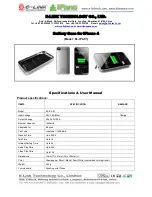
Section 12: Health and Safety Information
185
Consumer Information on Wireless Phones
Sect
ion 12
that sold devices that claimed to protect wireless phone
users from radiation with making false and
unsubstantiated claims. According to FTC, these
defendants lacked a reasonable basis to substantiate their
claim.
What about wireless phone interference with
medical equipment?
Radio frequency energy (RF) from wireless phones can
interact with some electronic devices. For this reason,
FDA helped develop a detailed test method to measure
electromagnetic interference (EMI) of implanted cardiac
pacemakers and defibrillators from wireless telephones.
This test method is now part of a standard sponsored by
the Association for the Advancement of Medical
instrumentation (AAMI). The final draft, a joint effort by
FDA, medical device manufacturers, and many other
groups, was completed in late 2000. This standard will
allow manufacturers to ensure that cardiac pacemakers
and defibrillators are safe from wireless phone EMI. FDA
has tested wireless phones and helped develop a
voluntary standard sponsored by the Institute of
Electrical and Electronic Engineers (IEEE). This standard
specifies test methods and performance requirements for
hearing aids and wireless phones so that no interference
occurs when a person uses a compatible phone and a
compatible hearing aid at the same time. This standard
was approved by the IEEE in 2000.
FDA continues to monitor the use of wireless phones for
possible interactions with other medical devices. Should
harmful interference be found to occur, FDA will conduct
a930.book Page 185 Friday, April 7, 2006 10:40 AM
Summary of Contents for A930 - Verizon Wireless
Page 4: ......
Page 50: ...50 Section 3 ...
Page 60: ...Section 4 60 ...
Page 100: ...100 Section 7 ...
Page 128: ...Section 8 128 ...
Page 154: ...154 Section 9 ...
Page 172: ...172 Section 11 ...
Page 202: ...Section 12 202 ...
Page 210: ...210 Section 13 ...
















































